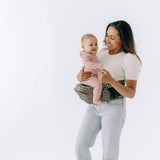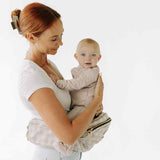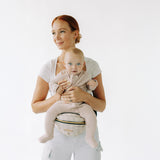Skin to Skin Baby Carrier: Does Babywearing Count as Skin-to-Skin?
Written by Connor Bringas on November 01, 2022.
If you’re a new parent or a soon-to-be parent, you may have heard of skin-to-skin contact. In this blog, we will review skin-to-skin contact and how it can be instrumental in bonding and influencing positive development for babies and their parents. Keep reading to see how the Tushbaby hip seat carrier’s design can make skin-to-skin contact an even more positive and comfortable experience.
Skin-to-Skin in a Baby Carrier & More
Table of Contents
- What is “skin-to-skin”?
- What is the purpose of skin-to-skin with a baby?
- Why is skin-to-skin important?
- How long should you do skin-to-skin?
- What counts as skin-to-skin contact?
- Benefits of skin-to-skin for mom, dad and baby
- Skin-to-skin time in the hospital
- How to do skin-to-skin at home
- Is skin-to-skin still beneficial at 2 months old?
- Can I do skin-to-skin in a baby carrier?
- Skin-to-skin safety in a baby carrier
What is “skin-to-skin”?
Just as it sounds, ‘skin-to-skin’ contact is the time spent with the baby laying on their parent’s bare chest. While this typically happens immediately following birth with mothers, this practice can go beyond that and even include dad. We will review some of the benefits of this sweet time with your baby below.
What is the purpose of skin-to-skin with a baby?
There are a variety of benefits that come from this time spent with your baby. One of the most important purposes of skin-to-skin contact is to strengthen the bond between babies and their parents. You may be wondering, what does this improved ‘bond’ mean? Bonding is defined as that strong attachment between parents and their babies that intensifies all our parental instincts like love, affection, and protection.
Why is skin-to-skin important?
An improved bond created from skin-to-skin contact between babies and their parents can lead to prolonged benefits as your baby develops and grows. Aside from the benefits for babies, skin-to-skin contact can provide benefits for parents too.
How long should you do skin-to-skin?
Immediately following childbirth, skin-to-skin is recommended for the first hour or until after the initial feeding — or longer if the mother wishes! Following childbirth, skin-to-skin time can remain a part of your routine for months. We will discuss how to implement this at home if you choose.
What counts as skin-to-skin contact?
Skin-to-skin is when a baby is lying with its belly on your chest. This can even be done with a blanket over the two of you or a cap on the baby's head for warmth. While in the hospital, it is common that your baby will be completely naked with a cap on their head. Some mothers choose to have a diaper on their baby, but it is recommended for your baby to be fully naked.
Benefits of skin-to-skin for mom, dad and baby
Skin-to-skin contact is known to promote bonding between babies and their parents. The additional benefits that this bonding creates exist for baby, mom, and dad. Many of the benefits listed here are due in part to the calming effect that this time with a baby produces.
For babies, one of the most immediate benefits of skin-to-skin contact is the physiological stress reliever from hormones produced during this contact. Oxytocin, our stress relief hormone, is released during skin-to-skin. Because of its stress-relieving ability, skin-to-skin is especially beneficial for babies and moms immediately following birth. The act of skin-to-skin can help keep your baby feeling calm, safe, and also helps in regulating their heartbeat and temperature.
For parents, skin-to-skin contact helps to form a stronger bond, leading to heightened parental instincts and increased confidence in their parenting skills. One of the most notable benefits for mothers is that skin-to-skin time can lead to an easier time when feeding. For mothers who breastfeed, skin-to-skin time can reduce stress, leading to better milk flow and making the transition to breastfeeding much easier. Dads can, of course, benefit from skin-to-skin time too, as this time creates a calming experience that will strengthen the bond between baby and dad.
Skin-to-skin time in the hospital
The moments following birth are very instrumental when seeking benefits from skin-to-skin time. Childbirth can be traumatic for both mom and especially baby, and this time can help as your baby’s bodily functions regulate themselves in the world. Be sure to speak with your care team if there are any health concerns that may hinder your ability to have this time. If mothers are unable to have that skin-to-skin time, partners can certainly step in and have that initial time with the baby.
How to do skin-to-skin at home
Going home with your little one can be an adjustment and sometimes feel overwhelming. In the months following birth, you can continue to enjoy the benefits that skin-to-skin time can offer at home. Snuggling up with your baby for skin-to-skin time can provide you both with some much-needed stress relief and relaxation together as you navigate your new norms.
At home, you will want to find a comfortable position and be sure you are practicing safe holding techniques. Babywearing can help you get safer skin-to-skin time in while tackling your to-do list at the same time. The Tushbaby is an open-face carrier that offers four carrying positions, all promoting skin-to-skin contact.
Is skin-to-skin still beneficial at 2 months old?
In addition to the benefits immediately following birth, continuing skin-to-skin contact at two months old remains beneficial. As mentioned, this practice is a stress reliever for both babies and parents and can help babies maintain and regulate their body temperature and heartbeat. The baby snuggles can surely continue to be enjoyable for parents too.
Can I do skin-to-skin in a baby carrier?
With all the benefits of skin-to-skin contact, you may wonder if it can be done with the support of a baby carrier. With Tushbaby’s hip seat carrier, you can make skin-to-skin holding an even more comfortable experience for you and your baby. You can use the Tushbaby in four carry positions for babies ranging from newborn to 36 months. This means you can utilize this additional support for early infancy skin-to-skin moments. Using the Tushbaby carrier in the feeding position will provide your baby a comfortable place to rest their body while giving you additional support for your arms and back.
Skin-to-skin safety in a baby carrier
As with any intended use of baby carriers, safety should be a number one priority. When using a baby carrier for skin-to-skin contact, here are some safety considerations to keep in mind:
- Safety for baby: When using a hip seat carrier for skin-to-skin contact, it's important that you are still providing proper support for your baby. While carriers are a great tool for parents, Tushbaby is not intended to be hands-free. Be sure to steady your baby with one arm, and in addition to proper support, be sure that your baby’s airways are exposed.
- Safety for caregivers: Baby carriers are a great way to prevent back and arm strain while holding your baby. Let’s face it, as parents, we spend a lot of time holding our babies, and that can add up. With the Tushbaby hip seat carrier, be sure to wear the carrier high and tight to best support your body.
For additional baby carrier safety information, read our blog on how to best keep your baby and yourself safe while enjoying the many benefits of your new Tushbaby carrier.


![Tushbaby photo - Women holding baby using tushbaby gray ::[15109665390658]](http://tushbaby.com/cdn/shop/files/GreyCarrier.webp?v=1762198155)
![Tushbaby photo - Women holding baby using tushbaby gray ::[15109665390658]](http://tushbaby.com/cdn/shop/files/Grey3.webp?v=1748543102)
![Tushbaby photo - Women holding baby using tushbaby gray ::[15109665390658]](http://tushbaby.com/cdn/shop/files/rKeAfN6W.webp?v=1748543102)
![Tushbaby photo - Women holding baby using tushbaby gray ::[15109665390658]](http://tushbaby.com/cdn/shop/files/Grey4_95ede319-844c-41db-96eb-608ec6a3b897.webp?v=1748543102)
![Tushbaby photo - Women holding baby using tushbaby gray ::[15109665390658]](http://tushbaby.com/cdn/shop/files/Grey2.webp?v=1748543102)
![Tushbaby photo - Women holding baby using tushbaby gray ::[15109665390658]](http://tushbaby.com/cdn/shop/files/Grey5.webp?v=1747418215)
![Tushbaby photo - Hip seat carrier,baby carrier hip seat,baby wrap carrier baby carrier wrap,baby carrier,baby wrap carriers,baby carriers,baby wraps,baby sling wrap,baby slings,baby wrap sling,carrier for big baby, toddler carrier, nursing carrier, breastfeeding carrier, diaper bag, baby belt carrier, strapless carrier, big kid carrier, special needs carrier,Tote,Diaper bag,Tote bag,Diaper pad,Changing pad,Pacifier pod,Coin purse,Vegan leather bag,Vegan tote,Vegan baby products,plus sized baby carrier::[15109665390658]](http://tushbaby.com/cdn/shop/files/Grey8.webp?v=1747418215)
![Tushbaby photo - Tushbaby grey holding bottle ::[15109665390658]](http://tushbaby.com/cdn/shop/files/Grey9.webp?v=1747418215)
![Tushbaby photo - Women using tushbaby::[15109665423426]](http://tushbaby.com/cdn/shop/files/BlackColor1.webp?v=1747418215)
![Tushbaby photo - man using tushbaby::[15109665423426]](http://tushbaby.com/cdn/shop/files/BlackColor2.webp?v=1747418215)
![Tushbaby photo - Women using tushbaby::[15109665423426]](http://tushbaby.com/cdn/shop/files/BlackColor3.webp?v=1747418215)
![Tushbaby photo - ::[15109665423426]](http://tushbaby.com/cdn/shop/files/BlackColor4.webp?v=1747418215)
![Tushbaby photo - ::[15109665423426]](http://tushbaby.com/cdn/shop/files/BlackColor5.webp?v=1747418215)
![Tushbaby photo - ::[15109665423426]](http://tushbaby.com/cdn/shop/files/BlackColor6.webp?v=1747418215)
![Tushbaby photo - ::[15109665423426]](http://tushbaby.com/cdn/shop/files/BlackColor7.webp?v=1747418215)
![Tushbaby photo - ::[15109665423426]](http://tushbaby.com/cdn/shop/files/BlackColor9.webp?v=1747418215)
![Tushbaby photo - Women using tushbaby::[15109665521730]](http://tushbaby.com/cdn/shop/files/Black_Gold1_3.webp?v=1747418215)
![Tushbaby photo - Women using tushbaby::[15109665521730]](http://tushbaby.com/cdn/shop/files/Black_Gold2.webp?v=1747418215)
![Tushbaby photo - Women using tushbaby::[15109665521730]](http://tushbaby.com/cdn/shop/files/Black_Gold3.webp?v=1747418215)
![Tushbaby photo - Women using tushbaby::[15109665521730]](http://tushbaby.com/cdn/shop/files/Black_Gold4.webp?v=1747418215)
![Tushbaby photo - Man using tushbaby::[15109665521730]](http://tushbaby.com/cdn/shop/files/Black_Gold5.webp?v=1747418215)
![Tushbaby photo - Women using tushbaby::[15109665521730]](http://tushbaby.com/cdn/shop/files/Black_Gold6.webp?v=1747418215)
![Tushbaby photo - Tushbaby::[15109665521730]](http://tushbaby.com/cdn/shop/files/Black_Gold7.webp?v=1747418215)
![Tushbaby photo - Tushbaby::[15109665521730]](http://tushbaby.com/cdn/shop/files/Black_Gold9.webp?v=1747418215)
![Tushbaby photo - ::[31311822422082]](http://tushbaby.com/cdn/shop/files/VeganLeatherBlack1.webp?v=1747418215)
![Tushbaby photo - ::[31311822422082]](http://tushbaby.com/cdn/shop/files/VeganLeatherBlack3.webp?v=1747418215)
![Tushbaby photo - ::[31311822422082]](http://tushbaby.com/cdn/shop/files/VeganLeatherBlack4.webp?v=1747418215)
![Tushbaby photo - ::[31311822422082]](http://tushbaby.com/cdn/shop/files/VeganLeatherBlack5.webp?v=1747418215)
![Tushbaby photo - ::[31311822422082]](http://tushbaby.com/cdn/shop/files/VeganLeatherBlack7.webp?v=1747418215)
![Tushbaby photo - ::[31311822422082]](http://tushbaby.com/cdn/shop/files/VeganLeatherBlack8.webp?v=1747418215)
![Tushbaby photo - ::[31311822422082]](http://tushbaby.com/cdn/shop/files/VeganLeatherBlack9.webp?v=1747418215)
![Tushbaby photo - ::[40092713287746]](http://tushbaby.com/cdn/shop/files/LiteCharcoal1.webp?v=1747418215)
![Tushbaby photo - ::[40092713287746]](http://tushbaby.com/cdn/shop/files/LiteCharcoal2.webp?v=1747418215)
![Tushbaby photo - ::[40092713287746]](http://tushbaby.com/cdn/shop/files/LiteCharcoal3.webp?v=1747418215)
![Tushbaby photo - ::[40092713287746]](http://tushbaby.com/cdn/shop/files/LiteCharcoal4.webp?v=1747418215)
![Tushbaby photo - ::[40092713287746]](http://tushbaby.com/cdn/shop/files/LiteCharcoal6.webp?v=1747418215)
![Tushbaby photo - ::[40092713287746]](http://tushbaby.com/cdn/shop/files/LiteCharcoal7.webp?v=1747418215)
![Tushbaby photo - ::[40092713287746]](http://tushbaby.com/cdn/shop/files/LiteCharcoal8.webp?v=1747418215)
![Tushbaby photo - ::[40092713320514]](http://tushbaby.com/cdn/shop/files/VelvetSable1.webp?v=1747418215)
![Tushbaby photo - ::[40092713320514]](http://tushbaby.com/cdn/shop/files/VelvetSable3.webp?v=1747418215)
![Tushbaby photo - ::[40092713320514]](http://tushbaby.com/cdn/shop/files/VelvetSable4.webp?v=1747418215)
![Tushbaby photo - ::[40092713320514]](http://tushbaby.com/cdn/shop/files/VelvetSable5.webp?v=1747418215)
![Tushbaby photo - ::[40092713320514]](http://tushbaby.com/cdn/shop/files/VelvetSable6.webp?v=1747418215)
![Tushbaby photo - ::[40092713320514]](http://tushbaby.com/cdn/shop/files/VelvetSable7.webp?v=1747418215)
![Tushbaby photo - ::[40092713320514]](http://tushbaby.com/cdn/shop/files/VelvetSable8.webp?v=1747418215)
![Tushbaby photo - ::[40288698040386]](http://tushbaby.com/cdn/shop/files/VeganLeatherCognac1.webp?v=1747418215)
![Tushbaby photo - ::[40288698040386]](http://tushbaby.com/cdn/shop/files/VeganLeatherCognac3.webp?v=1747418215)
![Tushbaby photo - ::[40288698040386]](http://tushbaby.com/cdn/shop/files/VeganLeatherCognac4.webp?v=1747418215)
![Tushbaby photo - ::[40288698040386]](http://tushbaby.com/cdn/shop/files/VeganLeatherCognac5.webp?v=1747418215)
![Tushbaby photo - ::[40288698040386]](http://tushbaby.com/cdn/shop/files/VeganLeatherCognac6.webp?v=1747418215)
![Tushbaby photo - ::[40288698040386]](http://tushbaby.com/cdn/shop/files/VeganLeatherCognac7.webp?v=1747418215)
![Tushbaby photo - ::[40288698040386]](http://tushbaby.com/cdn/shop/files/VeganLeatherCognac8.webp?v=1747418215)
![Tushbaby photo - ::[40288698040386]](http://tushbaby.com/cdn/shop/files/VeganLeatherCognac9.webp?v=1747418215)
![Tushbaby photo - ::[40288698040386]](http://tushbaby.com/cdn/shop/files/VeganLeatherCognac10.webp?v=1747418215)
![Tushbaby photo - ::[40503457382466]](http://tushbaby.com/cdn/shop/files/Orchid1Square.webp?v=1747418215)
![Tushbaby photo - ::[40503457382466]](http://tushbaby.com/cdn/shop/files/Orchid3Square.webp?v=1747418215)
![Tushbaby photo - ::[40503457382466]](http://tushbaby.com/cdn/shop/files/Orchid4Square.webp?v=1747418215)
![Tushbaby photo - ::[40503457382466]](http://tushbaby.com/cdn/shop/files/Orchid5Square.webp?v=1747418215)
![Tushbaby photo - ::[40503457382466]](http://tushbaby.com/cdn/shop/files/Orchid6Square.webp?v=1747418215)
![Tushbaby photo - ::[40503457382466]](http://tushbaby.com/cdn/shop/files/Orchid7Square.webp?v=1747418215)
![Tushbaby photo - ::[40503457382466]](http://tushbaby.com/cdn/shop/files/Orchid8Square.webp?v=1747418215)
![Tushbaby photo - ::[40503457382466]](http://tushbaby.com/cdn/shop/files/Orchid9Square.webp?v=1747418215)
![Tushbaby photo - ::[40503457382466]](http://tushbaby.com/cdn/shop/files/Orchid10Square.webp?v=1747418215)
![Tushbaby photo - ::[40288993017922]](http://tushbaby.com/cdn/shop/files/VeganLeatherCream1.webp?v=1747418215)
![Tushbaby photo - ::[40288993017922]](http://tushbaby.com/cdn/shop/files/VeganLeatherCream3.webp?v=1747418215)
![Tushbaby photo - ::[40288993017922]](http://tushbaby.com/cdn/shop/files/VeganLeatherCream4.webp?v=1747418215)
![Tushbaby photo - ::[40288993017922]](http://tushbaby.com/cdn/shop/files/VeganLeatherCream6.webp?v=1747418215)
![Tushbaby photo - ::[40288993017922]](http://tushbaby.com/cdn/shop/files/TBcream_blackseat2.jpg?v=1759513482)
![Tushbaby photo - ::[40288993017922]](http://tushbaby.com/cdn/shop/files/VeganLeatherCream7.webp?v=1759513482)
![Tushbaby photo - ::[40288993017922]](http://tushbaby.com/cdn/shop/files/VeganLeatherCream9.webp?v=1759513482)
![Tushbaby photo - ::[40503457415234]](http://tushbaby.com/cdn/shop/files/SnowLeopard1.webp?v=1759513482)
![Tushbaby photo - ::[40288993017922]](http://tushbaby.com/cdn/shop/files/TBcream_blackseat1_b994af6f-4e75-4f7b-b8ba-9750798bd0e7.jpg?v=1759513482)
![Tushbaby photo - ::[40503457415234]](http://tushbaby.com/cdn/shop/files/SnowLeopard3.webp?v=1759513482)
![Tushbaby photo - ::[40503457415234]](http://tushbaby.com/cdn/shop/files/SnowLeopard4.webp?v=1759513482)
![Tushbaby photo - ::[40503457415234]](http://tushbaby.com/cdn/shop/files/SnowLeopard5.webp?v=1759513482)
![Tushbaby photo - ::[40503457415234]](http://tushbaby.com/cdn/shop/files/SnowLeopard6.webp?v=1759513482)
![Tushbaby photo - ::[40503457415234]](http://tushbaby.com/cdn/shop/files/SnowLeopard7.webp?v=1759513482)
![Tushbaby photo - ::[40503457415234]](http://tushbaby.com/cdn/shop/files/SnowLeopard8.webp?v=1759513482)
![Tushbaby photo - ::[40503457415234]](http://tushbaby.com/cdn/shop/files/SnowLeopard9.webp?v=1759513482)
![Tushbaby photo - ::[40503457448002]](http://tushbaby.com/cdn/shop/files/Tweed1.-Square.webp?v=1759513482)
![Tushbaby photo - ::[40503457448002]](http://tushbaby.com/cdn/shop/files/Tweed3-Square.webp?v=1759513482)
![Tushbaby photo - ::[40503457448002]](http://tushbaby.com/cdn/shop/files/Tweed4-Square.webp?v=1759513482)
![Tushbaby photo - ::[40503457448002]](http://tushbaby.com/cdn/shop/files/Tweed5-Square.webp?v=1759513482)
![Tushbaby photo - ::[40503457448002]](http://tushbaby.com/cdn/shop/files/Tweed6-Square.webp?v=1759513482)
![Tushbaby photo - ::[40503457448002]](http://tushbaby.com/cdn/shop/files/Tweed8-Square.webp?v=1759513482)
![Tushbaby photo - ::[41633540800578]](http://tushbaby.com/cdn/shop/files/Marble1.webp?v=1759513482)
![Tushbaby photo - ::[41633540800578]](http://tushbaby.com/cdn/shop/files/Marble2.webp?v=1759513482)
![Tushbaby photo - ::[41633540800578]](http://tushbaby.com/cdn/shop/files/Marble4.webp?v=1759513482)
![Tushbaby photo - ::[41633540800578]](http://tushbaby.com/cdn/shop/files/Marble5.webp?v=1759513482)
![Tushbaby photo - ::[41633540800578]](http://tushbaby.com/cdn/shop/files/Marble6.webp?v=1759513482)
![Tushbaby photo - ::[41633540800578]](http://tushbaby.com/cdn/shop/files/Marble7.webp?v=1759513482)
![Tushbaby photo - ::[41633540800578]](http://tushbaby.com/cdn/shop/files/Marble8.webp?v=1759513482)
![Tushbaby photo - ::[41633540800578]](http://tushbaby.com/cdn/shop/files/Marble9.webp?v=1759513482)
![Tushbaby photo - ::[41984257556546]](http://tushbaby.com/cdn/shop/files/Olive1_297431f9-eeb3-411c-bc0e-08d37e703197.webp?v=1759513482)
![Tushbaby photo - ::[41984257556546]](http://tushbaby.com/cdn/shop/files/Olive2_bb6953ff-d61f-471a-b48f-3b36c7dbfb21.webp?v=1759513482)
![Tushbaby photo - ::[41984257556546]](http://tushbaby.com/cdn/shop/files/Olive3_97f99469-33f5-4192-9446-dcdfdbf32e84.webp?v=1759513482)
![Tushbaby photo - ::[41984257556546]](http://tushbaby.com/cdn/shop/files/Olive4_f9c88ddf-96de-476c-bef3-d57f9ddbd5c1.webp?v=1759513482)
![Tushbaby photo - ::[41984257556546]](http://tushbaby.com/cdn/shop/files/Olive5_e2741f35-99ec-4ed5-9307-809ef4ead286.webp?v=1759513482)
![Tushbaby photo - ::[41984257556546]](http://tushbaby.com/cdn/shop/files/Olive6_a66205d9-b767-4224-a04f-6e20597c7c38.webp?v=1759513482)
![Tushbaby photo - ::[41984257556546]](http://tushbaby.com/cdn/shop/files/Olive7_ab97dc70-f0b9-4a70-9137-943b8e3982e1.webp?v=1759513482)
![Tushbaby photo - ::[41984257556546]](http://tushbaby.com/cdn/shop/files/Olive8.webp?v=1759513482)
![Tushbaby photo - ::[41984257556546]](http://tushbaby.com/cdn/shop/files/Olive9.webp?v=1759513482)

![Tushbaby photo - ::[s-uper-image] ::[e-mbroidery]](http://tushbaby.com/cdn/shop/files/BlackLeather-Monogram1.webp?v=1759513482)
![Tushbaby photo - ::[s-uper-image] ::[e-mbroidery]](http://tushbaby.com/cdn/shop/files/Orchid-Monogram.webp?v=1759513482)







































![Tushbaby photo - Women holding baby using tushbaby gray ::[15109665390658]](http://tushbaby.com/cdn/shop/files/GreyCarrier_160x.webp?v=1762198155)
![Tushbaby photo - Women holding baby using tushbaby gray ::[15109665390658]](http://tushbaby.com/cdn/shop/files/Grey3_160x.webp?v=1748543102)
![Tushbaby photo - Women holding baby using tushbaby gray ::[15109665390658]](http://tushbaby.com/cdn/shop/files/rKeAfN6W_160x.webp?v=1748543102)
![Tushbaby photo - Women holding baby using tushbaby gray ::[15109665390658]](http://tushbaby.com/cdn/shop/files/Grey4_95ede319-844c-41db-96eb-608ec6a3b897_160x.webp?v=1748543102)
![Tushbaby photo - Women holding baby using tushbaby gray ::[15109665390658]](http://tushbaby.com/cdn/shop/files/Grey2_160x.webp?v=1748543102)
![Tushbaby photo - Women holding baby using tushbaby gray ::[15109665390658]](http://tushbaby.com/cdn/shop/files/Grey5_160x.webp?v=1747418215)
![Tushbaby photo - Hip seat carrier,baby carrier hip seat,baby wrap carrier baby carrier wrap,baby carrier,baby wrap carriers,baby carriers,baby wraps,baby sling wrap,baby slings,baby wrap sling,carrier for big baby, toddler carrier, nursing carrier, breastfeeding carrier, diaper bag, baby belt carrier, strapless carrier, big kid carrier, special needs carrier,Tote,Diaper bag,Tote bag,Diaper pad,Changing pad,Pacifier pod,Coin purse,Vegan leather bag,Vegan tote,Vegan baby products,plus sized baby carrier::[15109665390658]](http://tushbaby.com/cdn/shop/files/Grey8_160x.webp?v=1747418215)
![Tushbaby photo - Tushbaby grey holding bottle ::[15109665390658]](http://tushbaby.com/cdn/shop/files/Grey9_160x.webp?v=1747418215)
![Tushbaby photo - Women using tushbaby::[15109665423426]](http://tushbaby.com/cdn/shop/files/BlackColor1_160x.webp?v=1747418215)
![Tushbaby photo - man using tushbaby::[15109665423426]](http://tushbaby.com/cdn/shop/files/BlackColor2_160x.webp?v=1747418215)
![Tushbaby photo - Women using tushbaby::[15109665423426]](http://tushbaby.com/cdn/shop/files/BlackColor3_160x.webp?v=1747418215)
![Tushbaby photo - ::[15109665423426]](http://tushbaby.com/cdn/shop/files/BlackColor4_160x.webp?v=1747418215)
![Tushbaby photo - ::[15109665423426]](http://tushbaby.com/cdn/shop/files/BlackColor5_160x.webp?v=1747418215)
![Tushbaby photo - ::[15109665423426]](http://tushbaby.com/cdn/shop/files/BlackColor6_160x.webp?v=1747418215)
![Tushbaby photo - ::[15109665423426]](http://tushbaby.com/cdn/shop/files/BlackColor7_160x.webp?v=1747418215)
![Tushbaby photo - ::[15109665423426]](http://tushbaby.com/cdn/shop/files/BlackColor9_160x.webp?v=1747418215)
![Tushbaby photo - Women using tushbaby::[15109665521730]](http://tushbaby.com/cdn/shop/files/Black_Gold1_3_160x.webp?v=1747418215)
![Tushbaby photo - Women using tushbaby::[15109665521730]](http://tushbaby.com/cdn/shop/files/Black_Gold2_160x.webp?v=1747418215)
![Tushbaby photo - Women using tushbaby::[15109665521730]](http://tushbaby.com/cdn/shop/files/Black_Gold3_160x.webp?v=1747418215)
![Tushbaby photo - Women using tushbaby::[15109665521730]](http://tushbaby.com/cdn/shop/files/Black_Gold4_160x.webp?v=1747418215)
![Tushbaby photo - Man using tushbaby::[15109665521730]](http://tushbaby.com/cdn/shop/files/Black_Gold5_160x.webp?v=1747418215)
![Tushbaby photo - Women using tushbaby::[15109665521730]](http://tushbaby.com/cdn/shop/files/Black_Gold6_160x.webp?v=1747418215)
![Tushbaby photo - Tushbaby::[15109665521730]](http://tushbaby.com/cdn/shop/files/Black_Gold7_160x.webp?v=1747418215)
![Tushbaby photo - Tushbaby::[15109665521730]](http://tushbaby.com/cdn/shop/files/Black_Gold9_160x.webp?v=1747418215)
![Tushbaby photo - ::[31311822422082]](http://tushbaby.com/cdn/shop/files/VeganLeatherBlack1_160x.webp?v=1747418215)
![Tushbaby photo - ::[31311822422082]](http://tushbaby.com/cdn/shop/files/VeganLeatherBlack3_160x.webp?v=1747418215)
![Tushbaby photo - ::[31311822422082]](http://tushbaby.com/cdn/shop/files/VeganLeatherBlack4_160x.webp?v=1747418215)
![Tushbaby photo - ::[31311822422082]](http://tushbaby.com/cdn/shop/files/VeganLeatherBlack5_160x.webp?v=1747418215)
![Tushbaby photo - ::[31311822422082]](http://tushbaby.com/cdn/shop/files/VeganLeatherBlack7_160x.webp?v=1747418215)
![Tushbaby photo - ::[31311822422082]](http://tushbaby.com/cdn/shop/files/VeganLeatherBlack8_160x.webp?v=1747418215)
![Tushbaby photo - ::[31311822422082]](http://tushbaby.com/cdn/shop/files/VeganLeatherBlack9_160x.webp?v=1747418215)
![Tushbaby photo - ::[40092713287746]](http://tushbaby.com/cdn/shop/files/LiteCharcoal1_160x.webp?v=1747418215)
![Tushbaby photo - ::[40092713287746]](http://tushbaby.com/cdn/shop/files/LiteCharcoal2_160x.webp?v=1747418215)
![Tushbaby photo - ::[40092713287746]](http://tushbaby.com/cdn/shop/files/LiteCharcoal3_160x.webp?v=1747418215)
![Tushbaby photo - ::[40092713287746]](http://tushbaby.com/cdn/shop/files/LiteCharcoal4_160x.webp?v=1747418215)
![Tushbaby photo - ::[40092713287746]](http://tushbaby.com/cdn/shop/files/LiteCharcoal6_160x.webp?v=1747418215)
![Tushbaby photo - ::[40092713287746]](http://tushbaby.com/cdn/shop/files/LiteCharcoal7_160x.webp?v=1747418215)
![Tushbaby photo - ::[40092713287746]](http://tushbaby.com/cdn/shop/files/LiteCharcoal8_160x.webp?v=1747418215)
![Tushbaby photo - ::[40092713320514]](http://tushbaby.com/cdn/shop/files/VelvetSable1_160x.webp?v=1747418215)
![Tushbaby photo - ::[40092713320514]](http://tushbaby.com/cdn/shop/files/VelvetSable3_160x.webp?v=1747418215)
![Tushbaby photo - ::[40092713320514]](http://tushbaby.com/cdn/shop/files/VelvetSable4_160x.webp?v=1747418215)
![Tushbaby photo - ::[40092713320514]](http://tushbaby.com/cdn/shop/files/VelvetSable5_160x.webp?v=1747418215)
![Tushbaby photo - ::[40092713320514]](http://tushbaby.com/cdn/shop/files/VelvetSable6_160x.webp?v=1747418215)
![Tushbaby photo - ::[40092713320514]](http://tushbaby.com/cdn/shop/files/VelvetSable7_160x.webp?v=1747418215)
![Tushbaby photo - ::[40092713320514]](http://tushbaby.com/cdn/shop/files/VelvetSable8_160x.webp?v=1747418215)
![Tushbaby photo - ::[40288698040386]](http://tushbaby.com/cdn/shop/files/VeganLeatherCognac1_160x.webp?v=1747418215)
![Tushbaby photo - ::[40288698040386]](http://tushbaby.com/cdn/shop/files/VeganLeatherCognac3_160x.webp?v=1747418215)
![Tushbaby photo - ::[40288698040386]](http://tushbaby.com/cdn/shop/files/VeganLeatherCognac4_160x.webp?v=1747418215)
![Tushbaby photo - ::[40288698040386]](http://tushbaby.com/cdn/shop/files/VeganLeatherCognac5_160x.webp?v=1747418215)
![Tushbaby photo - ::[40288698040386]](http://tushbaby.com/cdn/shop/files/VeganLeatherCognac6_160x.webp?v=1747418215)
![Tushbaby photo - ::[40288698040386]](http://tushbaby.com/cdn/shop/files/VeganLeatherCognac7_160x.webp?v=1747418215)
![Tushbaby photo - ::[40288698040386]](http://tushbaby.com/cdn/shop/files/VeganLeatherCognac8_160x.webp?v=1747418215)
![Tushbaby photo - ::[40288698040386]](http://tushbaby.com/cdn/shop/files/VeganLeatherCognac9_160x.webp?v=1747418215)
![Tushbaby photo - ::[40288698040386]](http://tushbaby.com/cdn/shop/files/VeganLeatherCognac10_160x.webp?v=1747418215)
![Tushbaby photo - ::[40503457382466]](http://tushbaby.com/cdn/shop/files/Orchid1Square_160x.webp?v=1747418215)
![Tushbaby photo - ::[40503457382466]](http://tushbaby.com/cdn/shop/files/Orchid3Square_160x.webp?v=1747418215)
![Tushbaby photo - ::[40503457382466]](http://tushbaby.com/cdn/shop/files/Orchid4Square_160x.webp?v=1747418215)
![Tushbaby photo - ::[40503457382466]](http://tushbaby.com/cdn/shop/files/Orchid5Square_160x.webp?v=1747418215)
![Tushbaby photo - ::[40503457382466]](http://tushbaby.com/cdn/shop/files/Orchid6Square_160x.webp?v=1747418215)
![Tushbaby photo - ::[40503457382466]](http://tushbaby.com/cdn/shop/files/Orchid7Square_160x.webp?v=1747418215)
![Tushbaby photo - ::[40503457382466]](http://tushbaby.com/cdn/shop/files/Orchid8Square_160x.webp?v=1747418215)
![Tushbaby photo - ::[40503457382466]](http://tushbaby.com/cdn/shop/files/Orchid9Square_160x.webp?v=1747418215)
![Tushbaby photo - ::[40503457382466]](http://tushbaby.com/cdn/shop/files/Orchid10Square_160x.webp?v=1747418215)
![Tushbaby photo - ::[40288993017922]](http://tushbaby.com/cdn/shop/files/VeganLeatherCream1_160x.webp?v=1747418215)
![Tushbaby photo - ::[40288993017922]](http://tushbaby.com/cdn/shop/files/VeganLeatherCream3_160x.webp?v=1747418215)
![Tushbaby photo - ::[40288993017922]](http://tushbaby.com/cdn/shop/files/VeganLeatherCream4_160x.webp?v=1747418215)
![Tushbaby photo - ::[40288993017922]](http://tushbaby.com/cdn/shop/files/VeganLeatherCream6_160x.webp?v=1747418215)
![Tushbaby photo - ::[40288993017922]](http://tushbaby.com/cdn/shop/files/TBcream_blackseat2_160x.jpg?v=1759513482)
![Tushbaby photo - ::[40288993017922]](http://tushbaby.com/cdn/shop/files/VeganLeatherCream7_160x.webp?v=1759513482)
![Tushbaby photo - ::[40288993017922]](http://tushbaby.com/cdn/shop/files/VeganLeatherCream9_160x.webp?v=1759513482)
![Tushbaby photo - ::[40503457415234]](http://tushbaby.com/cdn/shop/files/SnowLeopard1_160x.webp?v=1759513482)
![Tushbaby photo - ::[40288993017922]](http://tushbaby.com/cdn/shop/files/TBcream_blackseat1_b994af6f-4e75-4f7b-b8ba-9750798bd0e7_160x.jpg?v=1759513482)
![Tushbaby photo - ::[40503457415234]](http://tushbaby.com/cdn/shop/files/SnowLeopard3_160x.webp?v=1759513482)
![Tushbaby photo - ::[40503457415234]](http://tushbaby.com/cdn/shop/files/SnowLeopard4_160x.webp?v=1759513482)
![Tushbaby photo - ::[40503457415234]](http://tushbaby.com/cdn/shop/files/SnowLeopard5_160x.webp?v=1759513482)
![Tushbaby photo - ::[40503457415234]](http://tushbaby.com/cdn/shop/files/SnowLeopard6_160x.webp?v=1759513482)
![Tushbaby photo - ::[40503457415234]](http://tushbaby.com/cdn/shop/files/SnowLeopard7_160x.webp?v=1759513482)
![Tushbaby photo - ::[40503457415234]](http://tushbaby.com/cdn/shop/files/SnowLeopard8_160x.webp?v=1759513482)
![Tushbaby photo - ::[40503457415234]](http://tushbaby.com/cdn/shop/files/SnowLeopard9_160x.webp?v=1759513482)
![Tushbaby photo - ::[40503457448002]](http://tushbaby.com/cdn/shop/files/Tweed1.-Square_160x.webp?v=1759513482)
![Tushbaby photo - ::[40503457448002]](http://tushbaby.com/cdn/shop/files/Tweed3-Square_160x.webp?v=1759513482)
![Tushbaby photo - ::[40503457448002]](http://tushbaby.com/cdn/shop/files/Tweed4-Square_160x.webp?v=1759513482)
![Tushbaby photo - ::[40503457448002]](http://tushbaby.com/cdn/shop/files/Tweed5-Square_160x.webp?v=1759513482)
![Tushbaby photo - ::[40503457448002]](http://tushbaby.com/cdn/shop/files/Tweed6-Square_160x.webp?v=1759513482)
![Tushbaby photo - ::[40503457448002]](http://tushbaby.com/cdn/shop/files/Tweed8-Square_160x.webp?v=1759513482)
![Tushbaby photo - ::[41633540800578]](http://tushbaby.com/cdn/shop/files/Marble1_160x.webp?v=1759513482)
![Tushbaby photo - ::[41633540800578]](http://tushbaby.com/cdn/shop/files/Marble2_160x.webp?v=1759513482)
![Tushbaby photo - ::[41633540800578]](http://tushbaby.com/cdn/shop/files/Marble4_160x.webp?v=1759513482)
![Tushbaby photo - ::[41633540800578]](http://tushbaby.com/cdn/shop/files/Marble5_160x.webp?v=1759513482)
![Tushbaby photo - ::[41633540800578]](http://tushbaby.com/cdn/shop/files/Marble6_160x.webp?v=1759513482)
![Tushbaby photo - ::[41633540800578]](http://tushbaby.com/cdn/shop/files/Marble7_160x.webp?v=1759513482)
![Tushbaby photo - ::[41633540800578]](http://tushbaby.com/cdn/shop/files/Marble8_160x.webp?v=1759513482)
![Tushbaby photo - ::[41633540800578]](http://tushbaby.com/cdn/shop/files/Marble9_160x.webp?v=1759513482)
![Tushbaby photo - ::[41984257556546]](http://tushbaby.com/cdn/shop/files/Olive1_297431f9-eeb3-411c-bc0e-08d37e703197_160x.webp?v=1759513482)
![Tushbaby photo - ::[41984257556546]](http://tushbaby.com/cdn/shop/files/Olive2_bb6953ff-d61f-471a-b48f-3b36c7dbfb21_160x.webp?v=1759513482)
![Tushbaby photo - ::[41984257556546]](http://tushbaby.com/cdn/shop/files/Olive3_97f99469-33f5-4192-9446-dcdfdbf32e84_160x.webp?v=1759513482)
![Tushbaby photo - ::[41984257556546]](http://tushbaby.com/cdn/shop/files/Olive4_f9c88ddf-96de-476c-bef3-d57f9ddbd5c1_160x.webp?v=1759513482)
![Tushbaby photo - ::[41984257556546]](http://tushbaby.com/cdn/shop/files/Olive5_e2741f35-99ec-4ed5-9307-809ef4ead286_160x.webp?v=1759513482)
![Tushbaby photo - ::[41984257556546]](http://tushbaby.com/cdn/shop/files/Olive6_a66205d9-b767-4224-a04f-6e20597c7c38_160x.webp?v=1759513482)
![Tushbaby photo - ::[41984257556546]](http://tushbaby.com/cdn/shop/files/Olive7_ab97dc70-f0b9-4a70-9137-943b8e3982e1_160x.webp?v=1759513482)
![Tushbaby photo - ::[41984257556546]](http://tushbaby.com/cdn/shop/files/Olive8_160x.webp?v=1759513482)
![Tushbaby photo - ::[41984257556546]](http://tushbaby.com/cdn/shop/files/Olive9_160x.webp?v=1759513482)

![Tushbaby photo - ::[s-uper-image] ::[e-mbroidery]](http://tushbaby.com/cdn/shop/files/BlackLeather-Monogram1_160x.webp?v=1759513482)
![Tushbaby photo - ::[s-uper-image] ::[e-mbroidery]](http://tushbaby.com/cdn/shop/files/Orchid-Monogram_160x.webp?v=1759513482)














































Leave a comment